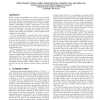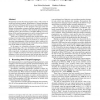108 search results - page 5 / 22 » Similar Code Detection and Elimination for Erlang Programs |
ACSAC
2004
IEEE
13 years 11 months ago
2004
IEEE
Buffer overflow vulnerabilities are caused by programming errors that allow an attacker to cause the program to write beyond the bounds of an allocated memory block to corrupt oth...
SIGSOFT
2005
ACM
14 years 1 months ago
2005
ACM
Cloning in software systems is known to create problems during software maintenance. Several techniques have been proposed to detect the same or similar code fragments in software...
ESORICS
2011
Springer
12 years 7 months ago
2011
Springer
Program authorship attribution—identifying a programmer based on stylistic characteristics of code—has practical implications for detecting software theft, digital forensics, a...
DAGSTUHL
2006
13 years 9 months ago
2006
Abstract. An overview of the concept of program similarity is presented. It divides similarity into two types--syntactic and semantic-and provides a review of eight categories of m...
ICFP
2010
ACM
13 years 8 months ago
2010
ACM
Programmers reason about their programs using a wide variety of formal and informal methods. Programmers in untyped languages such as Scheme or Erlang are able to use any such met...


